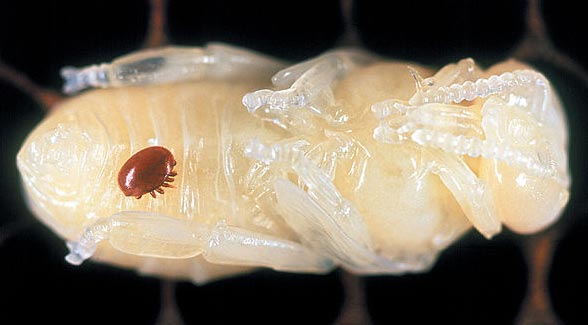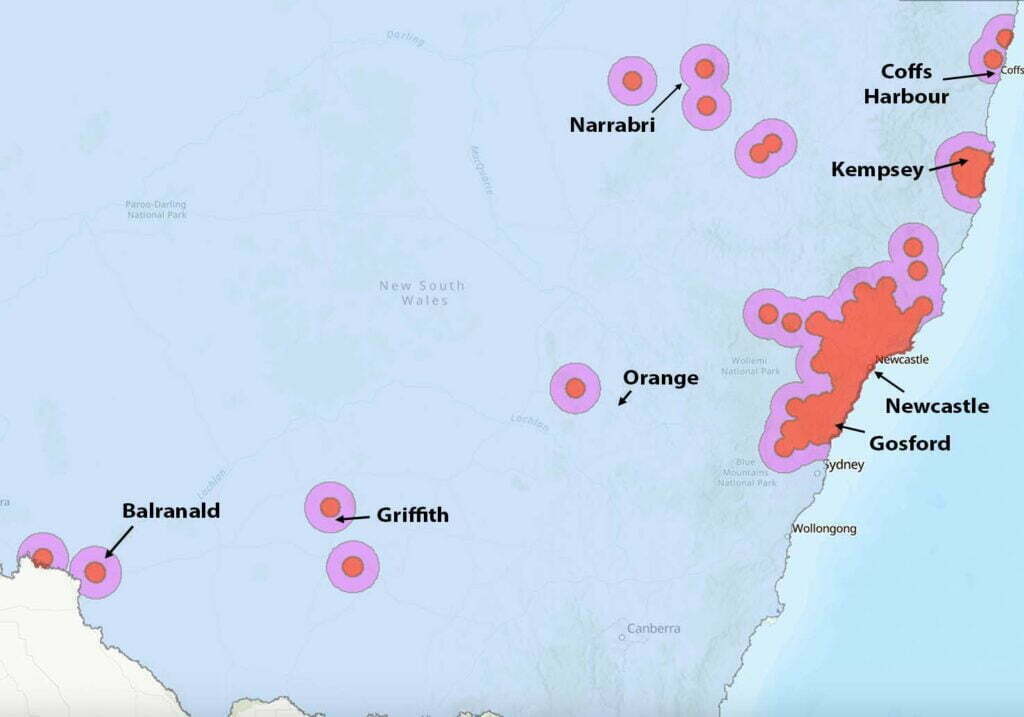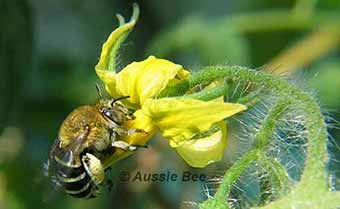How native bees could help save Australian agriculture
Dr Anne Dollin, Australian Native Bee Research Centre
The situation so far
Varroa Mites, a devastating parasite of European honeybees, were discovered in honeybee hives at Newcastle, NSW, on 22 June 2022. Sadly, by 15 September 2023, surveillance by the NSW Department of Primary Industries (DPI) revealed that Varroa Mites had spread to 277 locations in NSW (see Red Zones on map below).
The DPI declared Red Zones around each site where Varroa Mites were detected. Until 19 September 2023, the DPI ran a Fipronil baiting program in these Red Zones, in an attempt to eradicate the Varroa Mites.
Drastic steps were taken by the DPI to try to eradicate this Varroa Mite incursion. About 30,000 managed European honeybee hives were euthanised in the Red Zones shown in the map above and a baiting program to destroy feral nests of European honeybees was progressively rolled out in these areas.
Finally, on 19 September 2023, the National Management Group controlling the response made the decision that it was no longer feasible to eradicate the Varroa Mites from Australia. The Varroa Mite eradication work, including the baiting program, ended, and apiarists began work to manage this pest in their European honeybee hives instead.
Varroa Mites still remain active within large areas of NSW, especially in the Newcastle, Central Coast and Kempsey areas. Varroa Mites do not directly affect native bees (see Section 2). However, the after-effects of the DPI baiting program may continue to impact native bees for some time (see Section 3).
How will the Varroa Mite affect native bees?

Fortunately, research has shown that Varroa Mites cannot attack Australian native bees directly, as native bees have a very different biology from European honeybees.
Other flow-on effects are still possible though. Mite-infested hives of European honeybees may carry high levels of bee viruses and some of these viruses may spill over to native bees.
Varroa Mites, as they spread, will drastically reduce the number of feral European honeybee nests in the bush. This will reduce competition for nectar and pollen resources in the bush, which should benefit some native bee populations.
On the other hand, from late 2022 until September 2023, the DPI attempted to destroy all feral European honeybees in the Red Zones, using sugary baits containing Fipronil, a highly toxic pesticide. This baiting work has now ended. Nevertheless, residual pesticide in the environment could still impact native insects in these areas.
How has the eradication effort affected native bees?

In an effort to rid Australia of this devastating European honeybee parasite, the DPI tried to destroy all feral European honeybee colonies that were nesting in tree cavities in the Red Zones. By September 2023, the combined Red Zone areas covered over 1.5 million hectares.
The DPI eradication effort in the Red Zones involved the use of baits laced with the highly toxic pesticide, Fipronil. Pesticide residues in the environment could still impact local native bees and other pollinators in these areas.
Above: The DPI declared Red Zones around each site where Varroa Mites were detected. Until 19 September 2023, the DPI ran a Fipronil baiting program in these Red Zones, in an attempt to eradicate the Varroa Mites.
During the baiting program, many feral European honeybee foragers visited the baiting stations and took Fipronil back to their nests, killing these colonies. Unfortunately, Fipronil can remain active in honey for over two years (see reference 1). So, the stored honey in these poisoned feral European honeybee nests could still endanger native bees that are in the Red Zones for a long time (see reference 2).
It is difficult to know how much Fipronil could still be in the environment in a particular Red Zone, as this depends on many factors. More Information on this to come.
If you have native stingless bees in a Red Zone, there are steps you can take to protect your bees (See Section 4, below).
Do you have native bees in affected areas?
Native bees in the Red Zones (see map above) could be exposed to Fipronil, a highly toxic pesticide. Until 19 September 2023, the DPI Varroa Mite eradication program used Fipronil to poison feral European honeybee nests in the Red Zones (see details in Section 3, above). Honey in these dead nests may be contaminated with Fipronil and this pesticide could remain active for about two more years.
Our previous advice to people who had native stingless bees within a Red Zone was to remove these hives from the Red Zones for up to three years.
As we gather further information on the current situation, this advice still stands. More Information on this to come.
How native bees could help save Australian agriculture.
This crisis highlights the vital importance of developing native bees as alternative pollinators for Australian agricultural crops. As Varroa Mites gradually spread across the country, massive losses of European honeybees will occur throughout Australia. The pollination services of native bees and other insects will become crucial to support Australian agriculture.
Recent research in Australia has demonstrated that native bees, including our stingless bees and blue banded bees, can be effective pollinators of many Australian agricultural crops. Other Australian native insects, including flies, beetles, butterflies and wasps, also contribute important pollination services to crops.
New crop management systems, which help Australian native bees and other insects to perform their vital pollination services for our Australian agriculture, must be developed as a matter of great urgency!

A native bee alternative for crop growers: Blue-banded Bee.
Horticulturalists have been lobbying for many years to introduce European Bumblebees to Australia for crop pollination. Two Bumblebee import applications by horticulturalists in 1997 and 2004 have already been rejected by the Government because of the risk that exotic Bumblebees pose to Australian farms and bushland.
Bumblebees are used in many overseas countries to pollinate greenhouse crops such as tomatoes, cucumbers and eggplants. However, an Australian native bee alternative pollinator is available: the Blue Banded Bee.
This native bee could be an effective and practical solution for the tomato growers. Researchers at the University of Adelaide have shown that the Australian Blue Banded Bee, Amegilla:
- Can be bred year-round in large numbers
- Actively forages on greenhouse tomato crops throughout the temperature range used in Australian commercial greenhouses;
- Produces tomatoes 15-20% heavier than those that are currently produced by growers using their conventional vibration wand pollination system.
The importation of foreign Bumblebees should not even be considered when a promising native bee alternative is available.
Some husbandry issues with the Blue-banded Bee still need to be solved. However, the research has only received limited funding so far. Instead of continually lobbying for the introduction of exotic Bumblebees, the horticultural industry should support the development of this Australian native bee alternative pollinator.
References and further reading
- Taylor MA et. al. (2007) Destroying managed and feral honey bee (Apis mellifera) colonies to eradicate honey bee pests, New Zealand Journal of Crop and Horticultural Science, 35:3, 313-323, DOI: 10.1080/01140670709510197
- Koetz A and Hyatt S (2013) Asian honey bee (Apis cerana) remote nest treatment. Asian honey bee Transition to Management Program. Queensland Department of Agriculture, Fisheries and Forestry. Especially see summary point 3 on page 4, page 16, and the ‘Off-target species’ section on pages 17-18. www.planthealthaustralia.com.au/wp-content/uploads/2018/10/Asian-honey-bee-remote-nest-treatment-report.pdf
- Blue-banded bee research – Adelaide University 2012
- Aussie Bee Website – Promoting the Preservation and Enjoyment of Australian Native Bees. Australian Native Bee Research Centre, PO Box 74, North Richmond NSW 2754.
Further reading
- Transition to management of Varroa Mite – NSW Department of Primary Industries 19 September 2023
- Bee parasite varroa destructor fears lessened by native bees and insects for some growers – ABC News June 2022
- The Varroa Mite Eradication Program could impact your stingless bees – Australian Native Bee Association 9 October 2023
- Native Bees Newcastle
